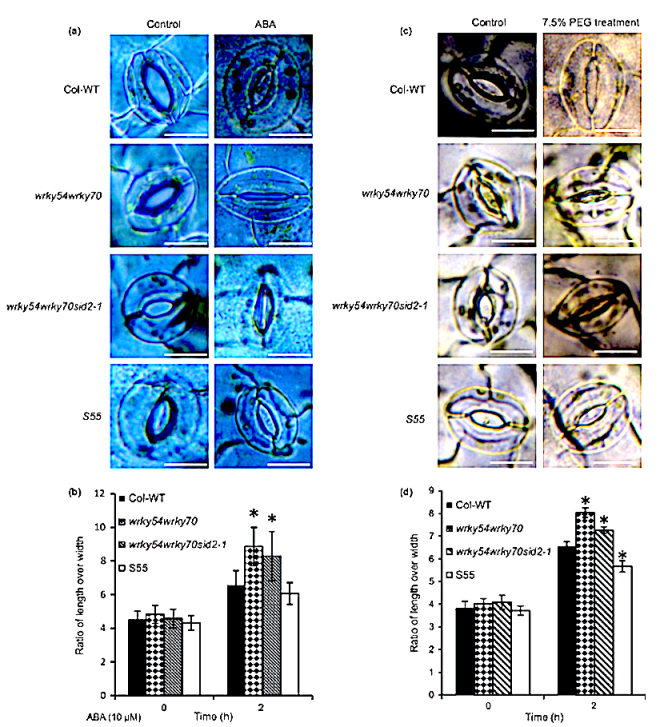
Fig. 1 Nanoinfusion of flg22 and ABA triggers rapid stomatal closure in intact Arabidopsis leaves. (a) Illustration of the nanoinfusion technique used to induce flg22- and ABA-dependent stomatal closure. A microcapillary was moved into the substomatal cavity of an open stoma and used to infuse solutions into the intercellular space. Movement of neighboring stomata was monitored on an upright microscope. (b) Images of a stoma in the abaxial epidermis of an Arabidopsis leaf stimulated by nanoinfusion of 20 nM flg22. Images were obtained just before (left panel), directly after (middle panel), and 35 min after stimulation with flg22 (right panel). Note that the leaf becomes transparent because of solution infused into the intercellular space. (c) Time-dependent changes in average stomatal aperture before and after stimulation with control solution (closed circles, n = 8), 10 lM ABA (open circles, n = 13), or 20 nM flg22 (open triangles, n = 13); the arrow indicates the time point of nanoinfusion. Data are presented as average values of 8 to 13 stomata of at least three independent experiments, and error bars represent SE.
Guard cell SLAC1-type anion channels mediate flagellin-induced stomatal closure
by Deger A. G., Scherzer S., Nuhkat M., Kedzierska J., Kollist H., Brosche M., Unyayar S., Boudsocq M., Hedrich R., Roelfsema M. R. G. (2015)
Aysin Guzel Deger
Mersin University – Faculty of Science and Letters, Department of Biology, Mersin, Turquie.
University of Würzburg – Molecular Plant Physiology and Biophysics, Julius-von-Sachs Institute for Biosciences, Biocenter, Würzburg, Allemagne.
Soenke Scherzer
University of Würzburg – Molecular Plant Physiology and Biophysics, Julius-von-Sachs Institute for Biosciences, Biocenter, Würzburg, Allemagne.
Maris Nuhkat
University of Tartu – Institute of Technology, Tartu, Estonie.
Justyna Kedzierska
University of Würzburg – Molecular Plant Physiology and Biophysics, Julius-von-Sachs Institute for Biosciences, Biocenter, Würzburg, Allemagne.
Hannes Kollist
University of Tartu – Institute of Technology, Tartu, Estonie.
Mikael Brosche
University of Helsinki – Division of Plant Biology, Department of Biosciences, Helsinki, Finlande.
University of Tartu – Institute of Technology, Tartu, Estonie.
Serpil Unyayar
Mersin University – Faculty of Science and Letters, Department of Biology, Mersin, Turquie.
Marie Boudsocq
INRA – U. Evry – U. Paris 11 (U. Paris Sud) – CNRS – U. Paris 7, UMR 1403 IPS2 Institut des Sciences des Plantes de Paris Saclay. Centre de recherche de Versailles-Grignon, Evry, France.
CNRS, Centre National de la Recherche Scientifique – UMR 9213 Institute of Plant Sciences Paris-Saclay, Université Paris Sud-Université Evry Val d’Essonne-Université Paris Diderot, Orsay, France.
Rainer Hedrich
University of Würzburg – Molecular Plant Physiology and Biophysics, Julius-von-Sachs Institute for Biosciences, Biocenter, Würzburg, Allemagne.
M. Rob G. Roelfsema
roelfsema@botanik.uni-wuerzburg.de
University of Würzburg – Molecular Plant Physiology and Biophysics, Julius-von-Sachs Institute for Biosciences, Biocenter, Würzburg, Allemagne.
——————————
in New Phytologist 208(1): 162-173 – DOI: 10.1111/nph.13435 –
https://helda.helsinki.fi/handle/10138/209596
http://onlinelibrary.wiley.com/store/10.1111/nph.13435/asset/nph13435.pdf;jsessionid=49EF146069C152693831AB7AE6B4AE9C.f03t03?v=1&t=j9qxsuc6&s=67dc0fb441bbdd3e6c3027ff6d5f4800c1985819
Abstract
During infection plants recognize microbe-associated molecular patterns (MAMPs), and this leads to stomatal closure.
This study analyzes the molecular mechanisms underlying this MAMP response and its interrelation with ABA signaling. Stomata in intact Arabidopsis thaliana plants were stimulated with the bacterial MAMP flg22, or the stress hormone ABA, by using the noninvasive nanoinfusion technique. Intracellular double-barreled microelectrodes were applied to measure the activity of plasma membrane ion channels.
Flg22 induced rapid stomatal closure and stimulated the SLAC1 and SLAH3 anion channels in guard cells. Loss of both channels resulted in cells that lacked flg22-induced anion channel activity and stomata that did not close in response to flg22 or ABA.
Rapid flg22-dependent stomatal closure was impaired in plants that were flagellin receptor (FLS2)-deficient, as well as in the ost1-2 (Open Stomata 1) mutant, which lacks a key ABA-signaling protein kinase.
By contrast, stomata of the ABA protein phosphatase mutant abi1-1 (ABscisic acid Insensitive 1) remained flg22-responsive.
These data suggest that the initial steps in flg22 and ABA signaling are different, but that the pathways merge at the level of OST1 and lead to activation of SLAC1 and SLAH3 anion channels.


You must be logged in to post a comment.